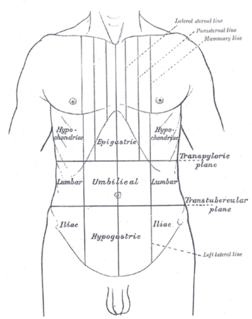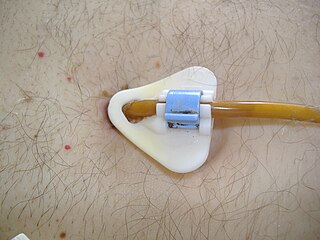Related Research Articles

Peritonitis is inflammation of the peritoneum, the lining of the inner wall of the abdomen and cover of the abdominal organs. Symptoms may include severe pain, swelling of the abdomen, fever, or weight loss. One part or the entire abdomen may be tender. Complications may include shock and acute respiratory distress syndrome.

Abdominal pain, also known as a stomach ache, is a symptom associated with both non-serious and serious medical issues.

Sanjay Gupta is an American neurosurgeon and medical reporter. He serves as associate chief of the neurosurgery service at Grady Memorial Hospital in Atlanta, Georgia, and as assistant professor of neurosurgery at the Emory University School of Medicine.

Percutaneous endoscopic gastrostomy (PEG) is an endoscopic medical procedure in which a tube is passed into a patient's stomach through the abdominal wall, most commonly to provide a means of feeding when oral intake is not adequate. This provides enteral nutrition despite bypassing the mouth; enteral nutrition is generally preferable to parenteral nutrition. The PEG procedure is an alternative to open surgical gastrostomy insertion, and does not require a general anesthetic; mild sedation is typically used. PEG tubes may also be extended into the small intestine by passing a jejunal extension tube through the PEG tube and into the jejunum via the pylorus.

Meropenem, sold under the brandname Merrem among others, is a broad-spectrum antibiotic used to treat a variety of bacterial infections. Some of these include meningitis, intra-abdominal infection, pneumonia, sepsis, and anthrax. It is given by injection into a vein.

Paracentesis is a form of body fluid sampling procedure, generally referring to peritoneocentesis in which the peritoneal cavity is punctured by a needle to sample peritoneal fluid.

Tigecycline is an antibiotic for a number of bacterial infections. It is a glycylcycline administered intravenously. It was developed in response to the growing rate of antibiotic resistant bacteria such as Staphylococcus aureus, Acinetobacter baumannii, and E. coli. As a tetracycline derivative antibiotic, its structural modifications has expanded its therapeutic activity to include Gram-positive and Gram-negative organisms, including those of multi-drug resistance.

Carbapenems are a class of highly effective antibiotic agents commonly used for the treatment of severe or high-risk bacterial infections. This class of antibiotics is usually reserved for known or suspected multidrug-resistant (MDR) bacterial infections. Similar to penicillins and cephalosporins, carbapenems are members of the beta lactam class of antibiotics, which kill bacteria by binding to penicillin-binding proteins, thus inhibiting bacterial cell wall synthesis. However, these agents individually exhibit a broader spectrum of activity compared to most cephalosporins and penicillins. Furthermore, carbapenems are typically unaffected by emerging antibiotic resistance, even to other beta-lactams.

Imipenem/cilastatin, sold under the brand name Primaxin among others, is an antibiotic useful for the treatment of a number of bacterial infections. It is made from a combination of imipenem and cilastatin. Specifically it is used for pneumonia, sepsis, endocarditis, joint infections, intra-abdominal infections, and urinary tract infections. It is given by injection into a vein or muscle.

Cefotaxime is an antibiotic used to treat a number of bacterial infections. Specifically it is used to treat joint infections, pelvic inflammatory disease, meningitis, pneumonia, urinary tract infections, sepsis, gonorrhea, and cellulitis. It is given either by injection into a vein or muscle.
Ampicillin/sulbactam is a combination of the common penicillin-derived antibiotic ampicillin and sulbactam, an inhibitor of bacterial beta-lactamase. Two different forms of the drug exist. The first, developed in 1987 and marketed in the United States under the tradename Unasyn, generic only outside the United States, is an intravenous antibiotic. The second, an oral form called sultamicillin, is marketed under the trade name Ampictam outside the United States. And generic only in the United States, ampicillin/sulbactam is used to treat infections caused by bacteria resistant to beta-lactam antibiotics. Sulbactam blocks the enzyme which breaks down ampicillin and thereby allows ampicillin to attack and kill the bacteria.

Peptostreptococcus is a genus of anaerobic, Gram-positive, non-spore forming bacteria. The cells are small, spherical, and can occur in short chains, in pairs or individually. They typically move using cilia. Peptostreptococcus are slow-growing bacteria with increasing resistance to antimicrobial drugs. Peptostreptococcus is a normal inhabitant of the healthy lower reproductive tract of women.
Abdominal guarding is the tensing of the abdominal wall muscles to guard inflamed organs within the abdomen from the pain of pressure upon them. The tensing is detected when the abdominal wall is pressed. Abdominal guarding is also known as 'défense musculaire'.

Abdominal trauma is an injury to the abdomen. Signs and symptoms include abdominal pain, tenderness, rigidity, and bruising of the external abdomen. Complications may include blood loss and infection.

A pyogenic liver abscess is a type of liver abscess caused by bacteria.
Dietmar H. Wittmann, M.D., Ph.D., FACS is an academic surgeon specializing in complex abdominal surgery. He was associated with the following medical schools: University of Hamburg, Germany, University of Düsseldorf, Germany, University of California San Francisco Medical School,USA, Hahnemann Medical School, Philadelphia,USA, Medical College of Wisconsin Milwaukee, USA. In addition to his clinical work, research, publications and teaching and lecturing worldwide, he is mostly known for his work relating to intra-abdominal infections, abdominal compartment syndrome abdominal compartment syndrome and staged abdominal repair STAR. Besides introducing the concept of calculated antimicrobial therapy Dr. Wittmann conceptualized the operative strategy of Staged Abdominal Repair (STAR) or the planned open abdomen to reverse the detrimental effects of the abdominal compartment syndrome and to treat imminent intra abdominal complications before they progress to life-threatening conditions. He is the inventor of a fascia prosthesis for temporary abdominal closure, the Artificial Bur Fascia Prosthesis (generic) or Wittmann Patch and Star Patch.

Eravacycline is a synthetic halogenated tetracycline class antibiotic in development by Tetraphase Pharmaceuticals. It is closely related to tigecycline. It has a broad spectrum of activity including many multi-drug resistant strains of bacteria. Phase III studies in complicated intra-abdominal infections (cIAI) and complicated urinary tract infections (cUTI) were recently completed with mixed results. Eravacycline has been granted fast track designation by the FDA.

Ceftolozane/tazobactam, sold under the brand name Zerbaxa, is a combination antibiotic. It is indicated for the treatment of complicated urinary tract infections and complicated intra-abdominal infections in adults. Ceftolozane is a cephalosporin antibiotic, developed for the treatment of infections with gram-negative bacteria that are resistant to conventional antibiotics. It was studied for urinary tract infections, intra-abdominal infections and ventilator-associated bacterial pneumonia.

Ceftazidime/avibactam, sold under the brand name Avycaz among others, is a combination medication composed of ceftazidime, a cephalosporin antibiotic, and avibactam, a β-lactamase inhibitor. It is used to treat complicated intra abdominal infections, urinary tract infections, and pneumonia. It is only recommended when other options are not appropriate. It is given by injection into a vein.
Imipenem/cilastatin/relebactam (Recarbrio) is a drug combination used as an antibiotic. In 2019, the United States approved it for complicated urinary tract and complicated intra-abdominal infections.
References
- 1 2 Sartelli, Massimo; Viale, Pierluigi; Catena, Fausto; Ansaloni, Luca; Moore, Ernest; Malangoni, Mark; Moore, Frederick A; Velmahos, George; Coimbra, Raul; Ivatury, Rao; Peitzman, Andrew; Koike, Kaoru; Leppaniemi, Ari; Biffl, Walter; Burlew, Clay Cothren; Balogh, Zsolt J; Boffard, Ken; Bendinelli, Cino; Gupta, Sanjay; Kluger, Yoram; Agresta, Ferdinando; Di Saverio, Salomone; Wani, Imtiaz; Escalona, Alex; Ordonez, Carlos; Fraga, Gustavo P; Junior, Gerson Alves Pereira; Bala, Miklosh; Cui, Yunfeng; Marwah, Sanjay; Sakakushev, Boris; Kong, Victor; Naidoo, Noel; Ahmed, Adamu; Abbas, Ashraf; Guercioni, Gianluca; Vettoretto, Nereo; Díaz-Nieto, Rafael; Gerych, Ihor; Tranà, Cristian; Faro, Mario Paulo; Yuan, Kuo-Ching; Kok, Kenneth Yuh Yen; Mefire, Alain Chichom; Lee, Jae Gil; Hong, Suk-Kyung; Ghnnam, Wagih; Siribumrungwong, Boonying; Sato, Norio; Murata, Kiyoshi; Irahara, Takayuki; Coccolini, Federico; Lohse, Helmut A Segovia; Verni, Alfredo; Shoko, Tomohisa (2013). "2013 WSES guidelines for management of intra-abdominal infections". World Journal of Emergency Surgery. 8 (1): 3. doi:10.1186/1749-7922-8-3. PMC 3545734 . PMID 23294512.